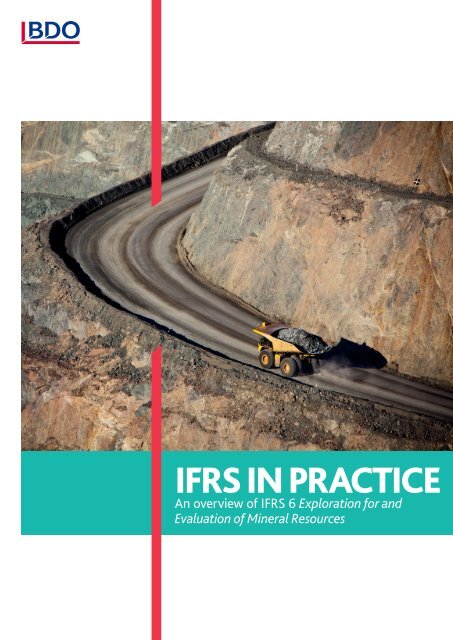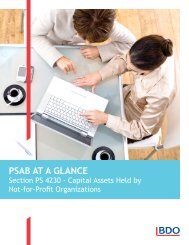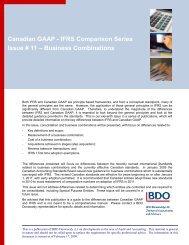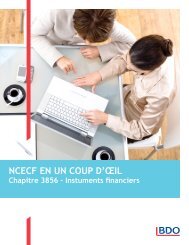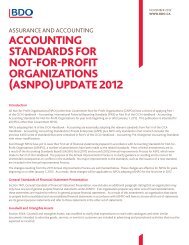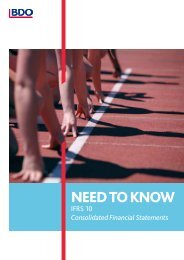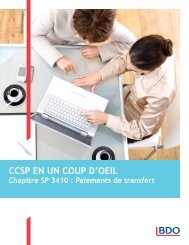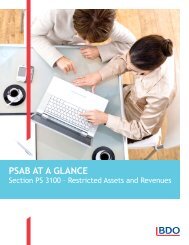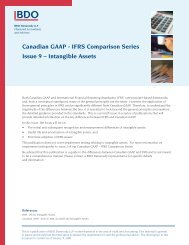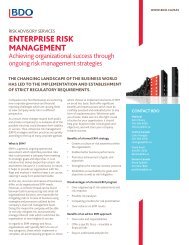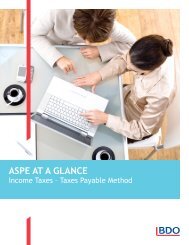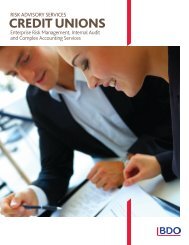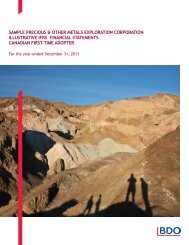IFRS 6 Exploration For and Evaluation of ... - BDO International
IFRS 6 Exploration For and Evaluation of ... - BDO International
IFRS 6 Exploration For and Evaluation of ... - BDO International
- No tags were found...
Create successful ePaper yourself
Turn your PDF publications into a flip-book with our unique Google optimized e-Paper software.
<strong>IFRS</strong> IN PRACTICEAn overview <strong>of</strong> <strong>IFRS</strong> 6 <strong>Exploration</strong> for <strong>and</strong><strong>Evaluation</strong> <strong>of</strong> Mineral Resources
2 <strong>IFRS</strong> IN PRACTICE - AN OVERVIEW OF <strong>IFRS</strong> 6 EXPLORATION FOR AND EVALUATION OF MINERAL RESOURCESTABLE OF CONTENTSIntroduction 3Scope 4Commonly asked questions 5Recognition <strong>of</strong> E&E expenditure 6Accounting policy choice – capitalise or expense E&E expenditure? 7Commonly asked questions 7Changes in accounting policy 10Commonly asked questions 10Classification <strong>of</strong> E&E expenditure 11Classification <strong>of</strong> cash flows 11Measurement <strong>of</strong> E&E expenditure 12Impairment 13Reversal <strong>of</strong> impairment 16Commonly asked questions 17Disclosure 18Farm in arrangements 19
4 <strong>IFRS</strong> IN PRACTICE - AN OVERVIEW OF <strong>IFRS</strong> 6 EXPLORATION FOR AND EVALUATION OF MINERAL RESOURCESSCOPEThe scope <strong>of</strong> <strong>IFRS</strong> 6 <strong>Exploration</strong> for <strong>and</strong> <strong>Evaluation</strong> <strong>of</strong> Mineral Resources is limited to the recognition, measurement <strong>and</strong>disclosure <strong>of</strong> expenditure incurred in the phase covering the E&E <strong>of</strong> mineral resources. Although the term used is ‘mineralresources’, the definitions in <strong>IFRS</strong> 6 clarify that this extends to cover minerals, oil, natural gas <strong>and</strong> other similar nonregenerativeresources meaning that it applies across the extractives industry sector.The limitation <strong>of</strong> scope to cover the exploration <strong>and</strong> evaluation phase means that <strong>IFRS</strong> 6 does not apply to expenditureincurred:––In the previous prospecting phase––In all phases after the E&E phase has been completed, including development, production, closure <strong>and</strong> rehabilitation.Prospecting ➔ <strong>Exploration</strong> ➔ <strong>Evaluation</strong> ➔ Development ➔ Production ➔Closure <strong>and</strong>rehabilitationThis was confirmed by the <strong>IFRS</strong> Interpretations Committee (previously the <strong>International</strong> Financial Reporting InterpretationsCommittee) at its meeting in January 2006. The Committee considered that <strong>IFRS</strong> 6 is clear in restricting its scope <strong>of</strong> <strong>IFRS</strong> 6to expenditure incurred in respect <strong>of</strong> E&E activities, <strong>and</strong> that there is no basis for interpreting <strong>IFRS</strong> 6 to provide any relief toareas outside its scope. Consequently, all <strong>of</strong> the requirements <strong>of</strong> <strong>IFRS</strong> apply to expenditure on other (non E&E) phases.However, there are some aspects <strong>of</strong> activities in the extractives industry which, even though they are outside the scope <strong>of</strong><strong>IFRS</strong> 6, are excluded from the scope <strong>of</strong> specific <strong>IFRS</strong>s. These include:––IAS 2 Inventories: does not apply to the measurement <strong>of</strong> inventories held by producers <strong>of</strong> minerals <strong>and</strong> mineral products, tothe extent that they are measured at net realisable value in accordance with well-established practice in those industries––IAS 16 Property, Plant <strong>and</strong> Equipment: does not apply to the recognition <strong>and</strong> measurement <strong>of</strong> exploration <strong>and</strong> evaluationassets. However, IAS 16 does apply to equipment which is used by entities in the extractives industry, regardless <strong>of</strong> thephase (for example, E&E or development)––IAS 17 Leases: does not apply to leases to explore for or use minerals, oil, natural gas <strong>and</strong> similar non-regenerativeresources. However, like IAS 16, IAS 17 does apply to leases <strong>of</strong> assets used by entities in the extractives industry, includingthose used in E&E activities. This links to IFRIC 4 Determining whether <strong>and</strong> Arrangement contains a Lease, which excludesfrom its scope only those arrangements which are scoped out <strong>of</strong> IAS 17––IAS 38 Intangible Assets: does not apply to expenditure on the development <strong>and</strong> extraction <strong>of</strong> minerals, oil, natural gas <strong>and</strong>similar non-regenerative resources––IAS 40 Investment Property: does not apply to mineral rights <strong>and</strong> mineral reserves such as oil, natural gas <strong>and</strong> similar nonregenerativeresources.Consequently, care is needed when determining precisely which expenditure falls within the scope <strong>of</strong> specific <strong>IFRS</strong>s. However,for those transactions which fall outside the scope <strong>of</strong> the <strong>IFRS</strong>s noted above, it would not be possible to apply <strong>IFRS</strong> 6 byanalogy in order to capitalise certain expenditure that other <strong>IFRS</strong>s would not permit to be capitalised. This is because thehierarchy in IAS 8 Accounting Policies, Changes in Accounting Estimates <strong>and</strong> Errors, under which an <strong>IFRS</strong> might be applied byanalogy, requires consideration <strong>of</strong> all <strong>of</strong> the criteria in IAS 8. As noted below in the section ‘Recognition <strong>of</strong> E&E expenditure’,<strong>IFRS</strong> 6 contains a specific exemption from certain <strong>of</strong> the requirements <strong>of</strong> IAS 8 which result in certain items <strong>of</strong> expenditurebeing eligible to be capitalised even though they do not meet the definition <strong>of</strong> an asset in the Conceptual Framework.
<strong>IFRS</strong> IN PRACTICE - AN OVERVIEW OF <strong>IFRS</strong> 6 EXPLORATION FOR AND EVALUATION OF MINERAL RESOURCES5COMMONLY ASKED QUESTIONSQuestion 1Do pre licence costs fall within the scope <strong>of</strong> E&E expenditure?Answer<strong>IFRS</strong> 6 states specifically that it does not apply to expenditure incurred before the exploration <strong>and</strong> evaluation <strong>of</strong> mineralresources, such as expenditure incurred before the entity has acquired the legal rights to explore a specific area.Pre licence costs arise before legal title has been obtained over a particular property. Consequently <strong>IFRS</strong> 6 does not apply,<strong>and</strong> the requirements <strong>of</strong> IAS 38 are applied instead.Question 2Can costs directly related to acquiring the legal title, that permits exploration <strong>and</strong> evaluation activities to be carried out, becapitalised?AnswerYes, if the entity has an accounting policy to capitalise E&E expenditure (see below). This is because these costs relate tothe acquisition <strong>of</strong> legal title <strong>and</strong> are therefore linked to an item which falls within the scope <strong>of</strong> <strong>IFRS</strong> 6 <strong>and</strong> qualifies to becapitalised.Question 3Can the cost <strong>of</strong> an option to acquire the legal right to explore a specific area be capitalised in accordance with <strong>IFRS</strong> 6?If not, does the cost qualify to be capitalised under another <strong>IFRS</strong>?AnswerIt depends. <strong>IFRS</strong> 6 states specifically that it does not apply to expenditure incurred before the exploration for an evaluation <strong>of</strong>mineral resources, such as expenditure incurred before the entity has acquired the legal rights to explore a specific area.Consequently, the acquisition <strong>of</strong> an option to acquire legal title does not, in itself, fall within the scope <strong>of</strong> <strong>IFRS</strong> 6. However,in some cases the terms <strong>of</strong> an option to acquire legal title permit the entity that has acquired the option to carry outE&E activities on the identified area. In those cases, the acquisition cost <strong>of</strong> the option can be capitalised within an E&E asset.If an option to acquire legal title does not permit the entity that has acquired the option to carry out E&E activities on theidentified area, assuming that the option is acquired at its fair value, in our view the acquisition cost does still qualify tobe capitalised. This is because the option meets the <strong>IFRS</strong> definition <strong>of</strong> an asset. However, questions may arise about which<strong>IFRS</strong> applies to the subsequent measurement <strong>of</strong> the option; depending on the precise terms <strong>and</strong> conditions, <strong>and</strong> the holder’spast practice <strong>and</strong> future intentions, the initial carrying amount <strong>of</strong> the option may simply be subject to impairment testsin accordance with IAS 36 Impairment <strong>of</strong> Assets or alternatively it may be within the scope <strong>of</strong> IAS 39 Financial Instruments:Recognition <strong>and</strong> Measurement. If the option is subsequently exercised, its carrying amount at that point will be included inthe initial carrying amount <strong>of</strong> the acquired legal right to explore.
6 <strong>IFRS</strong> IN PRACTICE - AN OVERVIEW OF <strong>IFRS</strong> 6 EXPLORATION FOR AND EVALUATION OF MINERAL RESOURCESRECOGNITION OF E&E EXPENDITURE<strong>IFRS</strong> 6 <strong>Exploration</strong> for <strong>and</strong> <strong>Evaluation</strong> <strong>of</strong> Mineral Resources includes an exemption, when determining accounting policies forE&E expenditure, from certain <strong>of</strong> the requirements <strong>of</strong> IAS 8 Accounting Policies, Changes in Accounting Estimates <strong>and</strong> Errors.These requirements are set out in IAS 8.11 <strong>and</strong> 12.The effect <strong>of</strong> the exemption is to permit a greater range <strong>of</strong> expenditure to qualify to be capitalised as an asset in comparisonwith the approach that would normally be followed under all <strong>of</strong> the requirements <strong>of</strong> <strong>IFRS</strong>. The IASB noted that existingpractice in the extractives industry varied substantially, ranging from deferral <strong>of</strong> virtually all E&E expenditure on balancesheet to expensing all E&E expenditure as incurred. In order to bring some limited improvements to accounting, while at thesame time minimising disruption to those entities that would adopt <strong>IFRS</strong> 6, the exemption from parts <strong>of</strong> IAS 8 was granted.In consequence, <strong>IFRS</strong> 6 permits entities to develop accounting policies for E&E expenditure that do not meet all <strong>of</strong> thedefinitions, recognition criteria <strong>and</strong> measurement concepts for assets, liabilities income <strong>and</strong> expenditure in <strong>IFRS</strong>. In practice,this results in:––E&E expenditure being capitalised, where that E&E expenditure would otherwise be likely to be regarded as researchexpenditure which IAS 38 Intangible Assets requires to be expensed as incurred––Either no recognition at all, or delayed recognition, <strong>of</strong> impairment <strong>of</strong> E&E assets in comparison with impairment that wouldbe recognised under the normal requirements <strong>of</strong> <strong>IFRS</strong>. This is because E&E assets are only assessed for impairment whenfacts <strong>and</strong> circumstances suggest that the carrying amount <strong>of</strong> capitalised E&E expenditure exceeds its recoverable amount,<strong>and</strong> on the transfer from E&E to development assets. Before these points, there is no requirement to assess whetherimpairment exists at the end <strong>of</strong> each reporting period––Specific approaches for ‘farm in’ transactions (see below for a discussion <strong>of</strong> these transactions), in which a portion orproportion <strong>of</strong> the risks <strong>and</strong> rewards associated with a property are transferred to another party in return for a fundingcommitment. The funding commitment may be in the form <strong>of</strong> an upfront payment, or be a commitment directly toundertake E&E activity, reimburse a specific amount <strong>of</strong> future E&E expenditure, or to share in a specified percentage <strong>of</strong>future expenditure.In practice, some entities may develop accounting policies for the recognition <strong>of</strong> assets during the E&E phase that take intoaccount the requirement to apply the more restrictive requirements <strong>of</strong> <strong>IFRS</strong> in full once the development stage is reached.
<strong>IFRS</strong> IN PRACTICE - AN OVERVIEW OF <strong>IFRS</strong> 6 EXPLORATION FOR AND EVALUATION OF MINERAL RESOURCES7ACCOUNTING POLICY CHOICE –CAPITALISE OR EXPENSE E&E EXPENDITURE?After determining which types <strong>of</strong> expenditure meet the definition <strong>of</strong> E&E expenditure, an entity has a choice <strong>of</strong> eithercapitalising or expensing each <strong>of</strong> these types <strong>of</strong> expenditure during the E&E phase. This is an accounting policy choice, tobe applied consistently. Consequently, there is a choice <strong>of</strong> capitalising no E&E expenditure, only some E&E expenditure, oralmost all E&E expenditure.<strong>IFRS</strong> 6 <strong>Exploration</strong> for <strong>and</strong> <strong>Evaluation</strong> <strong>of</strong> Mineral Resources identifies a number <strong>of</strong> different types <strong>of</strong> expenditure that might beconsidered for capitalisation:––Acquisition <strong>of</strong> rights to explore––Topographical, geological, geochemical <strong>and</strong> geophysical studies––Exploratory drilling––Trenching––Sampling––Activities in relation to evaluating the technical feasibility <strong>and</strong> commercial viability <strong>of</strong> extracting a mineral resource.<strong>BDO</strong> commentThe range <strong>of</strong> types <strong>of</strong> expenditure that are permitted to be capitalised as E&E assets are broad, including items such asdepreciation <strong>of</strong> property, plant <strong>and</strong> equipment, <strong>and</strong> consumables, with (depending on the unit <strong>of</strong> account used for an E&E area)even costs <strong>of</strong> failed test results being eligible to be capitalised.COMMONLY ASKED QUESTIONSQuestion 4An entity is in the process <strong>of</strong> carrying out E&E activities in a geographic area that it regards as an overall single explorationarea. It has an accounting policy <strong>of</strong> capitalising E&E expenditure. Costs are incurred on a test drilling a well that ultimatelyproves to be a ‘dry well’. Are these costs eligible to be capitalised into the entity’s E&E asset?AnswerYes. Because the entity regards the exploration area as a single asset, <strong>and</strong> does not split it into a number <strong>of</strong> separatecomponents, the cost <strong>of</strong> the dry well can be capitalised as it has added to the entity’s knowledge <strong>of</strong> the area <strong>of</strong> interest as awhole.Question 5Where expenditure is similar in nature, but has different probabilities <strong>of</strong> leading to a successful project, do the differentprobabilities mean that there is more than one type <strong>of</strong> expenditure? <strong>For</strong> example, exploratory drilling activities in differentcountries or areas may have different assessments <strong>of</strong> the probability <strong>of</strong> success. Does that mean that these exploratorydrilling activities should be split into components that reflect the probability <strong>of</strong> success in each country or area?AnswerThe fact that the same type <strong>of</strong> activity has different probabilities <strong>of</strong> success does not mean that the expenditure needs to bedivided into components. In this example, exploratory drilling activities would be regarded as a single type <strong>of</strong> expenditure(or unit <strong>of</strong> account), regardless <strong>of</strong> whether drilling in one country or area had a higher assessment <strong>of</strong> success than drilling inanother country or area.
8 <strong>IFRS</strong> IN PRACTICE - AN OVERVIEW OF <strong>IFRS</strong> 6 EXPLORATION FOR AND EVALUATION OF MINERAL RESOURCESQuestion 6Are finance costs either permitted or required to be capitalised?AnswerIAS 23 Borrowing Costs requires the capitalisation <strong>of</strong> borrowing costs that are directly attributable to the acquisition,construction or production <strong>of</strong> a qualifying asset. IAS 23.9 also notes that borrowing costs are capitalised as part <strong>of</strong> the cost<strong>of</strong> the related asset when it is probable that they will result in the entity obtaining future economic benefits.The interaction <strong>of</strong> the requirements <strong>of</strong> IAS 23 <strong>and</strong> <strong>IFRS</strong> 6 is not entirely clear. This is because the nature <strong>of</strong> E&E expendituremeans that it is unlikely that an entity will be able to satisfy the probability test for future economic benefits. Consequently,it could be argued that capitalising borrowing costs related to E&E assets is not permitted. However, while an approach <strong>of</strong>not capitalising borrowing costs is our preferred view, it can also be argued that IAS 23 does not override the exception in<strong>IFRS</strong> 6 from some <strong>of</strong> the requirements <strong>of</strong> IAS 8 Accounting Policies, Changes in Accounting Estimates <strong>and</strong> Errors, meaning thatit would be consistent with that exception to capitalise borrowing costs.Consequently, in our view an entity has an accounting policy choice, to be applied consistently, about whether it capitalisesborrowing costs associated with E&E activities. If an accounting policy <strong>of</strong> capitalising borrowing costs is adopted, care willbe required to ensure that the accounting treatment <strong>of</strong> borrowing costs is consistent with whether an entity chooses tocapitalise or expense certain types <strong>of</strong> expenditure in accordance with <strong>IFRS</strong> 6 (see above).Question 7Are administrative <strong>and</strong> other general overhead costs eligible for capitalisation as part <strong>of</strong> an E&E asset?Answer<strong>IFRS</strong> 6 does not specify whether administrative <strong>and</strong> other general overhead costs are eligible for capitalisation as part <strong>of</strong>an E&E asset. <strong>IFRS</strong> 6.BC28 notes that, during the development <strong>of</strong> the st<strong>and</strong>ard, an inconsistency was identified betweenIAS 2 Inventories paragraph 11 <strong>and</strong> IAS 38 Intangible Assets paragraph 67 which require directly attributable costs to becapitalised, <strong>and</strong> IAS 16 Property, Plant <strong>and</strong> Equipment paragraph 19 which prohibits the capitalisation <strong>of</strong> administrative <strong>and</strong>other general overhead costs.Consequently the question <strong>of</strong> whether administrative <strong>and</strong> other general overheads are capitalised as part <strong>of</strong> the cost <strong>of</strong> anE&E asset is an accounting policy choice, to be applied consistently. It would be appropriate for the accounting policy to bebased, by analogy, on either the requirements <strong>of</strong> IAS 2 <strong>and</strong> IAS 38, or the requirements <strong>of</strong> IAS 16; this approach is consistentwith the hierarchy <strong>of</strong> guidance to be followed when a particular <strong>IFRS</strong> does not cover a specific issue (see IAS 8.10-12).Question 8Entities that undertake E&E activities <strong>of</strong>ten incur related obligations for site restoration or asset decommissioning costs.<strong>IFRS</strong> 6.11 notes that provisions are recognised for those obligations in accordance with IAS 37 Provisions, Contingent Liabilities<strong>and</strong> Contingent Assets. How should the debit entries that arise from these liabilities be accounted for?AnswerThe general approach followed for an obligation for site restoration costs or asset decommissioning costs that arises on theinitial recognition <strong>of</strong> an asset, is for the debit entry to be added to the cost <strong>of</strong> the asset. Subsequent changes to the estimate<strong>of</strong> the obligation are added to or deducted from the cost <strong>of</strong> the related asset. Both <strong>of</strong> these elements are depreciated oramortised prospectively over the remaining useful life <strong>of</strong> the asset.However, for E&E assets the approach followed should link to the accounting policy adopted for, <strong>and</strong> accounting treatment<strong>of</strong>, the E&E expenditure itself. To the extent that the E&E expenditure that gives rise to the obligation is capitalised, the debitentry relating to the provision should similarly be capitalised. However, if the E&E expenditure is expensed as incurred, thenso too should the cost associated with the provision.Obligations relating to site restoration costs or asset decommissioning costs may be long term <strong>and</strong>, consequently, berecorded at discounted amounts. Any change in the carrying amount <strong>of</strong> the related provision should always be recognisedimmediately in pr<strong>of</strong>it or loss.
<strong>IFRS</strong> IN PRACTICE - AN OVERVIEW OF <strong>IFRS</strong> 6 EXPLORATION FOR AND EVALUATION OF MINERAL RESOURCES9Question 9If an entity chooses an accounting policy to capitalise E&E expenditure, what approaches are acceptable?AnswerA number <strong>of</strong> different methods <strong>of</strong> capitalising E&E expenditure have historically been used by entities in the extractivessector, in particular ‘successful efforts’, ‘area-<strong>of</strong>-interest’ <strong>and</strong> ‘full cost accounting’. A partial capitalisation approach is alsocommonly followed in practice.a) Successful effortsUnder this approach, in general only those costs that lead directly to the discovery, acquisition, or development <strong>of</strong> specific,discrete mineral reserves are capitalised. Costs that are known, when they are incurred, to fail to meet this criterion aregenerally charged to pr<strong>of</strong>it or loss as incurred. However, some interpretations <strong>of</strong> the successful efforts method wouldresult in capitalising the cost <strong>of</strong> unsuccessful development wells. This might be where an entity views a specified area asbeing a single cost centre (this may be smaller than an area-<strong>of</strong>-Interest – see below).b) Area-<strong>of</strong>-InterestAn area <strong>of</strong> interest is an individual geological area which is considered to constitute a favourable environment for thepresence <strong>of</strong> a mineral deposit or an oil or natural gas field. Under this approach, all E&E expenditure relating to an area<strong>of</strong> interest are grouped <strong>and</strong> capitalised, to the extent that the costs are expected to be recouped either through thesuccessful development <strong>and</strong> exploitation <strong>of</strong> the area, or by its sale.c) Full costThe full cost method generally results in capitalising all costs incurred in prospecting, acquiring mineral interests,exploration, appraisal, development <strong>and</strong> construction which are then accumulated in large cost centres. There arecertain aspects <strong>of</strong> full cost accounting that are not consistent with the requirements <strong>of</strong> <strong>IFRS</strong>. This includes capitalisingall pre licence acquisition costs (which are not within the scope <strong>of</strong> <strong>IFRS</strong> 6, as these do not form E&E activities), the needto classify E&E assets as tangible or intangible which is <strong>of</strong>ten not carried out for large asset pools, <strong>and</strong> the need to testE&E assets for impairment at the point at which E&E activity ceases <strong>and</strong> the assets are reclassified under IAS 16 or IAS 38(which is typically not possible, as full cost accounting does not disaggregate cost pools in the required level <strong>of</strong> detail).d) Partial capitalisationUnder this approach, only some costs that are eligible for capitalisation are included in an entity’s E&E asset. In somejurisdictions, a common approach is to capitalise initial acquisition costs for a particular mining asset <strong>and</strong> to expense allsubsequent costs.<strong>BDO</strong> comment<strong>For</strong> those entities in jurisdictions that transition to <strong>IFRS</strong>, <strong>IFRS</strong> 6 permits the continued application <strong>of</strong> many pre-<strong>IFRS</strong> accountingpolicies in respect <strong>of</strong> E&E expenditure, <strong>and</strong> permits a variety <strong>of</strong> approaches to the extent to which future E&E expenditure iscapitalised. Similarly, an entity commencing E&E activities that is established in a jurisdiction that has already adopted <strong>IFRS</strong> hasa choice <strong>of</strong> capitalising or expensing each type <strong>of</strong> E&E expenditure.Consequently there is little consistency globally in respect <strong>of</strong> the accounting for E&E expenditure, with accounting policiesbeing developed largely along previous GAAP/historic practice lines. However, larger entities, or those entities that operate injurisdictions more influenced by US GAAP, have <strong>of</strong>ten followed the ‘successful efforts’ method rather than ‘full cost’.As noted above, certain elements <strong>of</strong> full cost accounting are not consistent with the requirements <strong>of</strong> <strong>IFRS</strong> meaning that, whilean entity might use full cost as a starting point for the development <strong>of</strong> its accounting policy, a number <strong>of</strong> modifications will berequired.
10 <strong>IFRS</strong> IN PRACTICE - AN OVERVIEW OF <strong>IFRS</strong> 6 EXPLORATION FOR AND EVALUATION OF MINERAL RESOURCESCHANGES IN ACCOUNTING POLICY<strong>IFRS</strong> 6 <strong>Exploration</strong> for <strong>and</strong> <strong>Evaluation</strong> <strong>of</strong> Mineral Resources includes guidance for changes in the accounting policy appliedto E&E expenditure. A change in an entity’s accounting policy for E&E expenditure is permitted if this change makes thefinancial statements ‘more relevant to the decision making needs <strong>of</strong> users <strong>and</strong> no less reliable, or more reliable <strong>and</strong> no lessrelevant’ <strong>and</strong> brings the financial statements ‘closer to meeting the criteria in IAS 8’. The reference to IAS 8 AccountingPolicies, Changes in Accounting Estimates <strong>and</strong> Errors is relevant because <strong>IFRS</strong> 6 grants a temporary exemption from certainrequirements <strong>of</strong> IAS 8, including a requirement to consider the definition <strong>of</strong> an asset in the Conceptual Framework.This implies that a change in policy from capitalising all eligible E&E expenditure to successful efforts would be acceptable,as would a change from capitalising E&E expenditure to expensing all expenditure as incurred. This is because it is normallydifficult to demonstrate that the costs result in an item that meets the definition <strong>of</strong> an asset.COMMONLY ASKED QUESTIONSQuestion 10Can an entity change its accounting policy from expensing E&E expenditure to capitalising?AnswerIt would appear difficult to justify moving from an accounting policy <strong>of</strong> expensing all E&E expenditure as incurred to one<strong>of</strong> capitalising, as this would appear to result in accounting that is further away from the requirements <strong>of</strong> the Framework.However, it would be necessary to consider all relevant facts <strong>and</strong> circumstances.A change to capitalising E&E expenditure from a successful efforts basis to capitalising all eligible E&E expenditure mightbe more justifiable, which could be the case if an entity moved from capitalising one type <strong>of</strong> expenditure to two types (forexample, adding topological study costs to other costs that are capitalised). Again, all relevant facts <strong>and</strong> circumstances needto be considered.The exemption in <strong>IFRS</strong> 6 is designed to permit items to be capitalised even though they do not meet the <strong>IFRS</strong> definition <strong>of</strong>an asset. Consequently, if expenditure is incurred on an item that does meet the definition <strong>of</strong> an asset, then that item can becapitalised.
<strong>IFRS</strong> IN PRACTICE - AN OVERVIEW OF <strong>IFRS</strong> 6 EXPLORATION FOR AND EVALUATION OF MINERAL RESOURCES11CLASSIFICATION OF E&E EXPENDITUREIf an entity chooses an accounting policy to capitalise E&E expenditure, a question which then follows is whether thatexpenditure should be classified as a tangible or intangible asset, or as both tangible <strong>and</strong> intangible.<strong>IFRS</strong> 6 <strong>Exploration</strong> for <strong>and</strong> <strong>Evaluation</strong> <strong>of</strong> Mineral Resources paragraph 15 notes that E&E assets are classified as either tangibleor intangible, according to the nature <strong>of</strong> the assets acquired, <strong>and</strong> that this classification is applied consistently.Certain E&E assets will clearly be tangible (such as vehicles <strong>and</strong> equipment), while other expenditure will be less easy toclassify. An appropriate approach to follow would be to consider whether the costs incurred relate to a physical asset, orare related more to enhancing knowledge about where <strong>and</strong> how development activities should be carried out. <strong>For</strong> example,exploratory drilling activity is likely only to provide additional knowledge about the potential mineral reserves, <strong>and</strong> would beclassified as an intangible E&E asset.To the extent that a tangible asset is depreciated during E&E activities, with that depreciation reflecting the extent to whichthe tangible asset has been consumed, that deprecation would be added to the intangible E&E asset balance. However,<strong>IFRS</strong> 6.16 is explicit in stating that using a tangible asset to develop an intangible asset does not change a tangible asset intoan intangible asset.CLASSIFICATION OF CASH FLOWSThe classification <strong>of</strong> cash flows relating to E&E activities depends on whether the expenditure is capitalised as an E&E asset.To the extent that it is capitalised, the cash flows are classified as relating to investing activities as they have resulted in arecognised asset (IAS 7 Statement <strong>of</strong> Cash Flows paragraph 16). To the extent that the expenditure is expensed as incurred,the cash flows are classified as relating to operating activities.
<strong>IFRS</strong> IN PRACTICE - AN OVERVIEW OF <strong>IFRS</strong> 6 EXPLORATION FOR AND EVALUATION OF MINERAL RESOURCES13IMPAIRMENTE&E assets are required to be assessed for impairment (<strong>IFRS</strong> 6 <strong>Exploration</strong> for <strong>and</strong> <strong>Evaluation</strong> <strong>of</strong> Mineral Resourcesparagraph 18), with an impairment test being required when facts <strong>and</strong> circumstances suggest that the carrying amount <strong>of</strong>capitalised E&E expenditure exceeds its recoverable amount. However, the impairment requirements contained in <strong>IFRS</strong> 6differ from, <strong>and</strong> are considerably less strict, than the requirements <strong>of</strong> IAS 36 Impairment <strong>of</strong> Assets paragraphs 8-17. Inparticular, <strong>IFRS</strong> 6.20 sets out specific circumstances in which E&E assets are required to be tested for possible impairment.These reliefs from the full requirements <strong>of</strong> IAS 36 are significant, <strong>and</strong> mean that the determination <strong>of</strong> whether a project is inits E&E phase, or has reached the development or preproduction phase, is very important.<strong>IFRS</strong> 6.21-22 set out guidance for the allocation <strong>of</strong> E&E assets to cash generating units (CGUs) or groups <strong>of</strong> CGUs for thepurpose <strong>of</strong> impairment testing. Care is required when determining an entity’s CGUs <strong>and</strong> in the allocation <strong>of</strong> E&E assets tothose CGUs (see below).TRIGGERS FOR AN IMPAIRMENT TESTWhen identifying whether an E&E asset is required to be tested for impairment, <strong>IFRS</strong> 6.20 sets out the following indicators,while also noting that this is not an exhaustive list:a) The period for which the entity has the right to explore in the specific area has expired during the period, or will expirein the near future, <strong>and</strong> is not expected to be renewedb) Substantive expenditure on further exploration for <strong>and</strong> evaluation <strong>of</strong> mineral resources in the specific area is neitherbudgeted nor plannedc) <strong>Exploration</strong> for <strong>and</strong> evaluation <strong>of</strong> mineral resources in the specific areas have not led to the discovery <strong>of</strong> commerciallyviable quantities <strong>of</strong> mineral resources <strong>and</strong> the entity has decided to discontinue such activities in the specific aread) Sufficient data exists to indicate that, although a development in the specific area is likely to proceed, the carryingamount <strong>of</strong> the exploration <strong>and</strong> evaluation asset is unlikely to be recovered in full from successful development or sale.If any <strong>of</strong> the above conditions, or other similar conditions, exists then the E&E asset is required to be tested for impairmentin accordance with IAS 36. Other conditions that give rise to an impairment test may include significant adverse changes incommodity prices, <strong>and</strong> changes in tax or regulatory requirements.In its original exposure draft (the ED), the IASB proposed that IAS 36 should be applied in full, including the criteria fora trigger event for an impairment test. However, respondents to the ED noted that in some cases, <strong>and</strong> in particular forexploration only entities, exploration <strong>and</strong> evaluation assets do not generate cash flows <strong>and</strong> there is insufficient informationabout the mineral resources in a specific area to make reasonable estimates <strong>of</strong> exploration <strong>and</strong> evaluation assets’ recoverableamounts. This is because information sufficient to estimate future cash flows would typically not be available, meaning thatit would not be possible to estimate the two measures <strong>of</strong> recoverable amount in IAS 36 (fair value less costs to sell, or valuein use). Consequently, the application <strong>of</strong> the requirements for trigger events that give rise to an impairment test in IAS 36would result in an immediate write <strong>of</strong>f <strong>of</strong> E&E assets in many cases. In order to address this point, the IASB concluded that animpairment test <strong>of</strong> E&E assets should be triggered by changes in facts <strong>and</strong> circumstances.
14 <strong>IFRS</strong> IN PRACTICE - AN OVERVIEW OF <strong>IFRS</strong> 6 EXPLORATION FOR AND EVALUATION OF MINERAL RESOURCESTHE LEVEL AT WHICH IMPAIRMENT IS ASSESSED<strong>IFRS</strong> 6 permits the aggregation <strong>of</strong> CGUs for the purposes <strong>of</strong> impairment tests. <strong>IFRS</strong> 6.21 requires an accounting policy to bedeveloped for the allocation <strong>of</strong> E&E assets to CGUs (or groups <strong>of</strong> CGUs) for the purposes <strong>of</strong> an assessment for impairment.However, each CGU (or group <strong>of</strong> CGUs) is not permitted to be smaller than an operating segment as determined inaccordance with <strong>IFRS</strong> 8 Operating Segments.There is an important distinction to be drawn between an operating segment, <strong>and</strong> a reportable segment. Althoughreportable segments are included in the segment disclosures to financial statements, these can be made up <strong>of</strong> a number<strong>of</strong> operating segments which have been combined. Consequently care is required if CGUs are grouped for the purposes<strong>of</strong> impairment, as it is not possible simply to look to the segmental disclosures in an entity’s financial statements whenconsidering whether a particular aggregation is acceptable.Once the accounting policy for the allocation <strong>of</strong> E&E assets to CGUs (or groups <strong>of</strong> CGUs) has been determined, this approachis required to be applied consistently from one reporting period to the next. A change in accounting policy is only permittedif the criteria in IAS 8 Accounting Policies, Changes in Accounting Estimates <strong>and</strong> Errors for a change are met.<strong>BDO</strong> commentAlthough it might appear attractive to allocate E&E assets to a group <strong>of</strong> CGUs (to the extent permitted by the constraint placedon this by <strong>IFRS</strong> 8 – see above) for the purposes <strong>of</strong> impairment, this can give rise to practical issues. In particular, it might wellincrease the frequency with which the group <strong>of</strong> CGUs needs to be tested for impairment <strong>and</strong> could result in larger charges forimpairment. There are two scenarios which illustrate this point:1) Grouping projects that are close to commercial development with start-up projectsWhen an E&E asset moves into the development phase, <strong>IFRS</strong> 6.17 requires an impairment test to be carried out. Consequently,as each project moves to its commercial development phase, an impairment test <strong>of</strong> the entire CGU in which the asset isincluded will be required.2) Grouping projects that have a higher risk <strong>of</strong> being unsuccessful with ongoing E&E projectsEach time a project is found to be unsuccessful, <strong>IFRS</strong> 6.20 requires an impairment test to be carried out. Consequently, eachtime a higher risk E&E project does not lead to the discovery <strong>of</strong> commercially viable quantities <strong>of</strong> mineral resources, animpairment test <strong>of</strong> the entire CGU in which the asset arising from the project is included will be required.
<strong>IFRS</strong> IN PRACTICE - AN OVERVIEW OF <strong>IFRS</strong> 6 EXPLORATION FOR AND EVALUATION OF MINERAL RESOURCES15EXAMPLE, POSSIBLE SCENARIOS AND QUESTIONSCompany A is exploring for oil in a known oil basin in West Africa. The oil basin stretches across the borders <strong>of</strong> countries X<strong>and</strong> Y. Company A is carrying out E&E activities in both countries <strong>and</strong>, out <strong>of</strong> 40 specified exploration areas, has the rightsto areas 1, 2, 20, 26, 27 <strong>and</strong> 40. Areas 1, 2 <strong>and</strong> 20 are located in country X, <strong>and</strong> areas 26, 27 <strong>and</strong> 40 are located in country Y.Areas 1 <strong>and</strong> 2 are adjacent to each other, as are areas 26 <strong>and</strong> 27, <strong>and</strong> 20 <strong>and</strong> 40.Scenario 1Company A has started to drill a planned total <strong>of</strong> 1,000 test wells in area 26. Five wells have been completed, with onlywater having been found. Company A intends to continue with its test drilling.QuestionDoes the failure <strong>of</strong> the first five test wells to find oil represent an impairment trigger under the requirements <strong>of</strong> <strong>IFRS</strong> 6.20?AnswerThis question will typically arise when an entity follows a policy <strong>of</strong> capitalising all eligible E&E expenditure. Under thisapproach, the unit <strong>of</strong> account for the purposes <strong>of</strong> accounting for E&E assets could be determined as being the area overwhich Company A has a right to explore. Because Company A intends to continue its E&E activities in area 26, this indicatesthat an impairment trigger has not occurred. The costs associated with the five test wells are carried forward as anE&E asset, on the basis that the results <strong>of</strong> drilling provide useful information about the licence area as a whole.Scenario 2Company A has completed drilling its planned 1,000 test wells in area 20. Although the results indicate the presence <strong>of</strong>hydrocarbon reserves, Company A concludes that it will not actively bring area 20 into production due to an unfavourabletax <strong>and</strong> regulatory regime that has been implemented in country X. However, Company A does intend to continueE&E activities in the adjacent area 40, which is located in country Y. The decision to continue E&E activities in area 40 ispartly based on the results <strong>of</strong> test drilling in area 20.QuestionIs Company A’s decision not to continue to production in area 20 a trigger for an impairment test? (A linked <strong>and</strong> relevantquestion, which needs to be answered first, is whether areas 20 <strong>and</strong> 40 can be viewed as being a single unit <strong>of</strong> account,despite the fact that they are in different countries).AnswerDetermination <strong>of</strong> the unit <strong>of</strong> account is not defined in <strong>IFRS</strong> 6, <strong>and</strong> constitutes a key judgement. Many entities view theunit <strong>of</strong> account to be the area <strong>of</strong> interest (<strong>and</strong> so will apply either area-<strong>of</strong>-interest or full cost accounting for the purposes<strong>of</strong> their E&E assets). An area <strong>of</strong> interest can be based on a geological feature that lends itself to a unified exploration <strong>and</strong>development effort, <strong>and</strong> can be made up from a number <strong>of</strong> adjacent geographic areas that have separate licences attachedto them. Consequently, it could be argued that areas 20 <strong>and</strong> 40 constitute one combined area <strong>of</strong> interest, <strong>and</strong> that there hasbeen no trigger for an impairment test.
16 <strong>IFRS</strong> IN PRACTICE - AN OVERVIEW OF <strong>IFRS</strong> 6 EXPLORATION FOR AND EVALUATION OF MINERAL RESOURCESREVERSAL OF IMPAIRMENTAfter a charge for impairment has been made, this is reversed for assets other than goodwill (that is, capitalised E&E assets<strong>and</strong> property, plant <strong>and</strong> equipment) if there is a subsequent increase in the recoverable amount calculated in accordancewith IAS 36 Impairment <strong>of</strong> Assets.Example 1Company B is carrying out E&E activities in country X. A requirement <strong>of</strong> the licence to carry out E&E activities is that Company Bincurs a specified minimum amount <strong>of</strong> exploration expenditure in each year. Due to a collapse in investor confidence, Company Bdetermines the end <strong>of</strong> its financial year that it is unlikely that it will be able to raise sufficient funds to meet the minimum spendingrequirement. Consequently, a charge for impairment <strong>of</strong> its E&E asset is included in its financial statements.Shortly after the financial statements have been approved, the government <strong>of</strong> country X grants a three year exemption from theminimum spend requirement.In this case, the reason for the original charge for impairment has been eliminated. Provided Company B now expects to continueto carry out E&E activities <strong>and</strong> there are no other indicators <strong>of</strong> impairment that need to be considered, the original charge forimpairment is reversed.However, the ability to reverse an impairment loss is dependent on the original asset not having been derecognised. In somecircumstances, E&E activities may not result in the discovery <strong>of</strong> mineral reserves <strong>and</strong> E&E activities are ab<strong>and</strong>oned. In thesecircumstances, the E&E assets are derecognised <strong>and</strong> any subsequent developments, such as the discovery <strong>of</strong> mineral reservesdue to improved technology, will not result in a reversal <strong>of</strong> the impairment charge for the previous E&E assets that have beenderecognised.E&E assets are also derecognised if, for example, an entity loses the right to explore in a specific area.Example 2Company A is carrying out E&E activities in country Z. Due to a change <strong>of</strong> government, all existing licences for E&E <strong>and</strong>mining activities are cancelled <strong>and</strong> the State takes control <strong>of</strong> all projects. Consequently, Company A ab<strong>and</strong>ons itsE&E projects in country Z, <strong>and</strong> impairs <strong>and</strong> derecognises the related E&E assets.5 years later, following another change in government, Company A secures new rights to carry out E&E <strong>and</strong> mining activities.Although future E&E expenditure is eligible for capitalisation (assuming that this is Company A’s accounting policy), theimpairment <strong>of</strong> the original E&E asset cannot be reversed, even if the area being explored is the same, as the originalE&E asset was derecognised.
<strong>IFRS</strong> IN PRACTICE - AN OVERVIEW OF <strong>IFRS</strong> 6 EXPLORATION FOR AND EVALUATION OF MINERAL RESOURCES17COMMONLY ASKED QUESTIONSQuestion 11Company A has a 31 December financial year end, with its annual report being approved in March 20X3. An exploratorydrilling programme was undertaken during the period from October 20X2 to January 20X3, with the results being evaluatedin February 20X3. The analysis shows that no commercial deposits exist <strong>and</strong> Company A determines that it will cease tocarry out E&E activities.Is Company A required to include a charge for impairment <strong>of</strong> the E&E asset in its financial statements for the yearended 20X2?AnswerYes. Because the test results provide information about the exploration area about conditions that existed at the financialyear end (there are no commercial deposits), all E&E expenditure that has been capitalised up to 31 December 20X2 isrequired to be written <strong>of</strong>f.Question 12As a variation on question 10, would the answer change if the exploratory drilling programme was not carried out until theearly part <strong>of</strong> 20X3?AnswerNo. The E&E asset recorded at 31 December 20X2 would be written <strong>of</strong>f, because the test results obtained in early 20X3provide information confirming that, at 31 December 20X2, there were no commercial deposits. However, the costs <strong>of</strong> theexploratory drilling programme would not be accrued at 31 December 20X2, instead being expensed in the year ending31 December 20X3.
18 <strong>IFRS</strong> IN PRACTICE - AN OVERVIEW OF <strong>IFRS</strong> 6 EXPLORATION FOR AND EVALUATION OF MINERAL RESOURCESDISCLOSURE<strong>IFRS</strong> 6 <strong>Exploration</strong> for <strong>and</strong> <strong>Evaluation</strong> <strong>of</strong> Mineral Resources paragraphs 23-25 set out a number <strong>of</strong> specific disclosurerequirements. The overall requirement is for an entity:‘…to disclose information that identifies <strong>and</strong> explains the amounts recognised in its financial statements arising from theexploration for <strong>and</strong> evaluation <strong>of</strong> mineral resources.’In order to comply with this requirement, both the following disclosures need to be made:––Accounting policies for exploration <strong>and</strong> evaluation expenditures, including the recognition <strong>of</strong> exploration <strong>and</strong> evaluationassets––The amounts <strong>of</strong> assets, liabilities income <strong>and</strong> expense <strong>and</strong> operating <strong>and</strong> investing cash flows arising from the exploration<strong>and</strong> evaluation <strong>of</strong> mineral resources.E&E assets are treated as separate classes <strong>of</strong> assets, with the disclosures required by IAS 16 Property, Plant <strong>and</strong> Equipment <strong>and</strong>IAS 38 Intangible Assets being made consistently with the classification <strong>of</strong> E&E assets.In addition, IAS 1 Presentation <strong>of</strong> Financial Statements paragraphs 122 <strong>and</strong> 125 are likely to require additional disclosuresrelating to E&E activities. IAS 1.122 requires disclosures relating to significant judgements (apart from those involvingestimations) that management has made in the process <strong>of</strong> applying the entity’s accounting policies <strong>and</strong> that have the mostsignificant effect on amounts recognised in the financial statements. IAS 1.125 requires information to be disclosed aboutthe assumptions that have been made about the future, <strong>and</strong> other major sources <strong>of</strong> estimation uncertainty at the end <strong>of</strong>the reporting period, that have a significant risk <strong>of</strong> resulting in a material adjustment to the carrying amounts <strong>of</strong> assets <strong>and</strong>liabilities within the next financial year.
<strong>IFRS</strong> IN PRACTICE - AN OVERVIEW OF <strong>IFRS</strong> 6 EXPLORATION FOR AND EVALUATION OF MINERAL RESOURCES19FARM IN ARRANGEMENTSIt is common for entities involved in the E&E phase (<strong>and</strong> other phases) <strong>of</strong> extractive activities to enter into ‘farm in’arrangements with third parties. Under a farm in arrangement, an entity engaged in E&E activities (the farmor) gives up theright to future reserves in exchange for a reduction in future funding obligations which will be met by another party (thefarmee). In addition to costs being shared among entities, one <strong>of</strong> the drivers for these arrangements is to share the risksassociated with the extractive project with one or more other parties.The arrangements result in the transfer <strong>of</strong> a proportion <strong>of</strong> a property in exchange for a commitment from the farmee to fundcertain obligations. Consequently, from the farmor’s perspective, a farm in arrangement represents the complete disposal <strong>of</strong>a proportion <strong>of</strong> a property.<strong>IFRS</strong> 6 <strong>Exploration</strong> for <strong>and</strong> <strong>Evaluation</strong> <strong>of</strong> Mineral Resources paragraph 4 notes that:‘The <strong>IFRS</strong> does not address other aspects <strong>of</strong> accounting by entities engagement in the exploration for <strong>and</strong> evaluation <strong>of</strong> mineralresources.’This brings the question <strong>of</strong> whether farm in arrangements fall within the scope <strong>of</strong> <strong>IFRS</strong> 6. However, because thesearrangements result in the recognition by the farmee <strong>of</strong> E&E activities <strong>and</strong> (potentially) a disposal <strong>of</strong> part <strong>of</strong> an E&E asset bythe farmor, we consider that <strong>IFRS</strong> 6 is not precluded from being applied to these arrangements. Consequently the farmor hasa choice <strong>of</strong> developing an accounting policy in accordance with <strong>IFRS</strong> 6, or developing an accounting policy in accordance withIAS 8 Accounting Policies, Changes in Accounting Estimates <strong>and</strong> Errors.If an accounting policy is developed in accordance with <strong>IFRS</strong> 6, meaning that the exemption from certain <strong>of</strong> the requirements<strong>of</strong> IAS 8 applies, the approach followed will <strong>of</strong>ten be based on the approach that many entities previously applied under theirown national GAAPs. In summary:––The farmor will not record any expenditure (whether this would otherwise have been capitalised or expensed immediately)that is settled by the farmee––The farmor does not recognise a gain or loss on the basis <strong>of</strong> the partial disposal <strong>of</strong> any E&E asset that has already beencapitalised. Instead, any proceeds received that are not attributable to future expenditure are simply credited against thecarrying amount <strong>of</strong> any existing E&E asset––To the extent that the proceeds received from the farmee exceed the carrying amount <strong>of</strong> any E&E asset that has alreadybeen capitalised by the farmor, this excess is recognised as a gain in pr<strong>of</strong>it or loss.If an accounting policy is developed in accordance with IAS 8, this might result in the partial derecognition <strong>of</strong> any E&E assetthat has been capitalised, with a corresponding gain on disposal.
20 <strong>IFRS</strong> IN PRACTICE - AN OVERVIEW OF <strong>IFRS</strong> 6 EXPLORATION FOR AND EVALUATION OF MINERAL RESOURCESExample 1Company A owns 100% <strong>of</strong> the rights to explore <strong>and</strong> mine area Z, <strong>and</strong> has spent <strong>and</strong> capitalised Currency Units (CU)1,000 todate. Company A (the farmor) enters into an agreement under which it sells 25% <strong>of</strong> the property to Company B (the farmee)for CU1,000.Accounting in accordance with an accounting policy developed in accordance with <strong>IFRS</strong> 6The proceeds are set against the carrying value <strong>of</strong> the E&E asset:Dr CashCr E&E assetCU1,000CU1,000Accounting in accordance with an accounting policy developed in accordance with IAS 8The farm in is accounted for as a partial disposal <strong>of</strong> the E&E asset:Dr CashCr E&E assetCr Pr<strong>of</strong>it on disposalCU1,000CU250CU750Example 2Company A owns 100% <strong>of</strong> the rights to explore <strong>and</strong> mine area Z, <strong>and</strong> has spent CU1,000 to date, <strong>of</strong> which CU500 has beencapitalised as an E&E asset. Company A (the farmor) enters into an agreement under which it sells 25% <strong>of</strong> the property toCompany B (the farmee) for CU1,000.Accounting in accordance with an accounting policy developed in accordance with <strong>IFRS</strong> 6The proceeds are set against the carrying value <strong>of</strong> the E&E asset to the extent <strong>of</strong> its carrying amount, with the excess beingcredited to pr<strong>of</strong>it or loss:Dr CashCr E&E assetCr Other incomeCU1,000CU500CU500Accounting in accordance with an accounting policy developed in accordance with IAS 8The farm in is accounted for as a partial disposal <strong>of</strong> the E&E asset:Dr CashCr E&E assetCr Pr<strong>of</strong>it on disposalCU1,000CU125CU875
<strong>IFRS</strong> IN PRACTICE - AN OVERVIEW OF <strong>IFRS</strong> 6 EXPLORATION FOR AND EVALUATION OF MINERAL RESOURCES21
CONTACT<strong>For</strong> further information about how <strong>BDO</strong> can assist you <strong>and</strong> your organisation,please get in touch with one <strong>of</strong> our key contacts listed below. Alternatively, please visitwww.bdointernational.com/Services/Audit/<strong>IFRS</strong>/<strong>IFRS</strong> Country Leaders where you can findfull lists <strong>of</strong> regional <strong>and</strong> country contacts.EUROPEAlain Frydlender France alain.frydlender@bdo.frJens Freiberg Germany jens.freiberg@bdo.deTeresa Morahan Irel<strong>and</strong> tmorahan@bdo.ieEhud Greenberg Israel ehudg@bdo.co.ilRuud Vergoossen Netherl<strong>and</strong>s ruud.vergoossen@bdo.nlReidar Jensen Norway reidar.jensen@bdo.noDenis Taradov Russia d.taradov@bdo.ruRené Krügel Switzerl<strong>and</strong> rene.kruegel@bdo.chPauline McGee United Kingdom pauline.mcgee@bdo.co.ukASIA PACIFICWayne Basford Australia wayne.basford@bdo.com.auZheng Xian Hong China zheng.xianhong@bdo.com.cnFanny Hsiang Hong Kong fannyhsiang@bdo.com.hkManoj Daga India manoj.daga@bdoindia.co.inKhoon Yeow Tan Malaysia tanky@bdo.myLATIN AMERICAMarcelo Canetti Argentina mcanetti@bdoargentina.comLuis Pierrend Peru lpierrend@bdo.com.peErnesto Bartesaghi Uruguay ebartesaghi@bdo.com.uyNORTH AMERICA & CARIBBEANArm<strong>and</strong> Capisciolto Canada acapisciolto@bdo.caWendy Hambleton USA whambleton@bdo.comMIDDLE EASTRupert Dodds Bahrain rupert.dodds@bdo.bhAntoine Gholam Lebanon agholam@bdo-lb.comSUB SAHARAN AFRICANigel Griffith South Africa ngriffith@bdo.co.zaThis publication has been carefully prepared, but it has been written in general terms <strong>and</strong> should be seen as broad guidance only. The publication cannot be relied upon to cover specific situations<strong>and</strong> you should not act, or refrain from acting, upon the information contained therein without obtaining specific pr<strong>of</strong>essional advice. Please contact your respective <strong>BDO</strong> member firm to discussthese matters in the context <strong>of</strong> your particular circumstances. Neither <strong>BDO</strong> IFR Advisory Limited, Brussels Worldwide Services BVBA, <strong>BDO</strong> <strong>International</strong> Limited <strong>and</strong>/or <strong>BDO</strong> member firms, northeir respective partners, employees <strong>and</strong>/or agents accept or assume any liability or duty <strong>of</strong> care for any loss arising from any action taken or not taken by anyone in reliance on the information inthis publication or for any decision based on it.Service provision within the international <strong>BDO</strong> network <strong>of</strong> independent member firms (‘the <strong>BDO</strong> network’) in connection with <strong>IFRS</strong> (comprising <strong>International</strong> Financial Reporting St<strong>and</strong>ards,<strong>International</strong> Accounting St<strong>and</strong>ards, <strong>and</strong> Interpretations developed by the <strong>IFRS</strong> Interpretations Committee <strong>and</strong> the former St<strong>and</strong>ing Interpretations Committee), <strong>and</strong> other documents, as issued bythe <strong>International</strong> Accounting St<strong>and</strong>ards Board, is provided by <strong>BDO</strong> IFR Advisory Limited, a UK registered company limited by guarantee. Service provision within the <strong>BDO</strong> network is coordinated byBrussels Worldwide Services BVBA, a limited liability company incorporated in Belgium with its statutory seat in Brussels.Each <strong>of</strong> <strong>BDO</strong> <strong>International</strong> Limited (the governing entity <strong>of</strong> the <strong>BDO</strong> network), Brussels Worldwide Services BVBA, <strong>BDO</strong> IFR Advisory Limited <strong>and</strong> the member firms is a separate legal entity <strong>and</strong>has no liability for another such entity’s acts or omissions. Nothing in the arrangements or rules <strong>of</strong> the <strong>BDO</strong> network shall constitute or imply an agency relationship or a partnership between<strong>BDO</strong> <strong>International</strong> Limited, Brussels Worldwide Services BVBA, <strong>BDO</strong> IFR Advisory Limited <strong>and</strong>/or the member firms <strong>of</strong> the <strong>BDO</strong> network.<strong>BDO</strong> is the br<strong>and</strong> name for the <strong>BDO</strong> network <strong>and</strong> for each <strong>of</strong> the <strong>BDO</strong> member firms.© 2013 <strong>BDO</strong> IFR Advisory Limited, a UK registered company limited by guarantee. All rights reserved.www.bdointernational.com 1302-01


